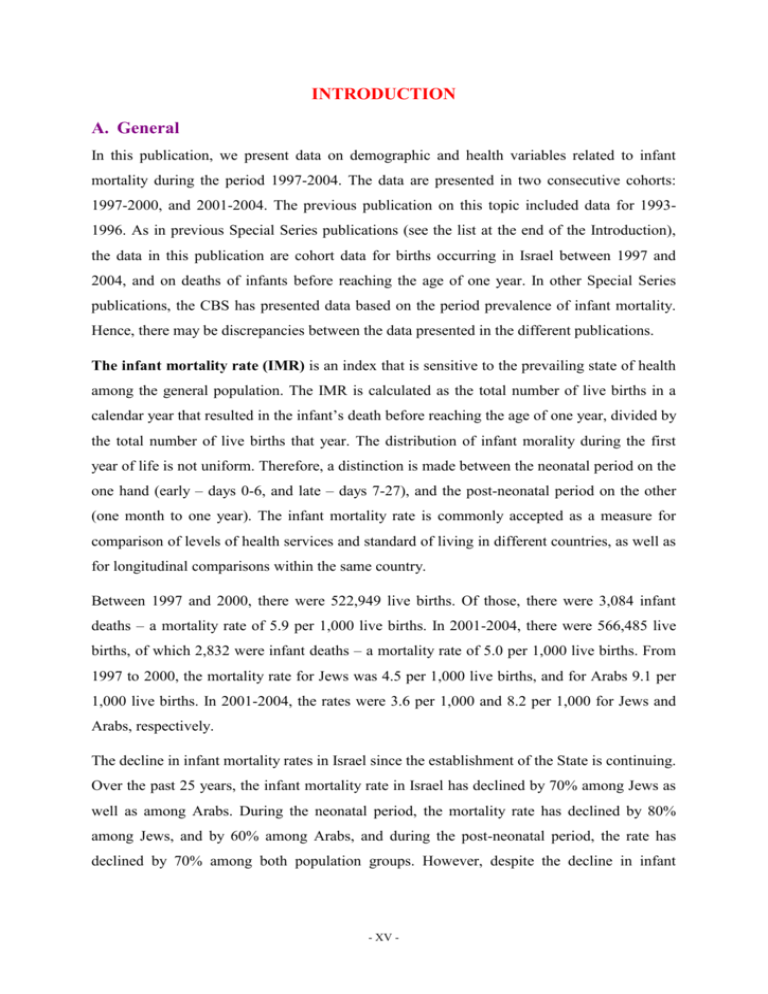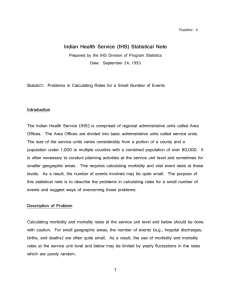INTRODUCTION
advertisement

INTRODUCTION A. General In this publication, we present data on demographic and health variables related to infant mortality during the period 1997-2004. The data are presented in two consecutive cohorts: 1997-2000, and 2001-2004. The previous publication on this topic included data for 19931996. As in previous Special Series publications (see the list at the end of the Introduction), the data in this publication are cohort data for births occurring in Israel between 1997 and 2004, and on deaths of infants before reaching the age of one year. In other Special Series publications, the CBS has presented data based on the period prevalence of infant mortality. Hence, there may be discrepancies between the data presented in the different publications. The infant mortality rate (IMR) is an index that is sensitive to the prevailing state of health among the general population. The IMR is calculated as the total number of live births in a calendar year that resulted in the infant’s death before reaching the age of one year, divided by the total number of live births that year. The distribution of infant morality during the first year of life is not uniform. Therefore, a distinction is made between the neonatal period on the one hand (early – days 0-6, and late – days 7-27), and the post-neonatal period on the other (one month to one year). The infant mortality rate is commonly accepted as a measure for comparison of levels of health services and standard of living in different countries, as well as for longitudinal comparisons within the same country. Between 1997 and 2000, there were 522,949 live births. Of those, there were 3,084 infant deaths – a mortality rate of 5.9 per 1,000 live births. In 2001-2004, there were 566,485 live births, of which 2,832 were infant deaths – a mortality rate of 5.0 per 1,000 live births. From 1997 to 2000, the mortality rate for Jews was 4.5 per 1,000 live births, and for Arabs 9.1 per 1,000 live births. In 2001-2004, the rates were 3.6 per 1,000 and 8.2 per 1,000 for Jews and Arabs, respectively. The decline in infant mortality rates in Israel since the establishment of the State is continuing. Over the past 25 years, the infant mortality rate in Israel has declined by 70% among Jews as well as among Arabs. During the neonatal period, the mortality rate has declined by 80% among Jews, and by 60% among Arabs, and during the post-neonatal period, the rate has declined by 70% among both population groups. However, despite the decline in infant - XV - mortality rates among both groups, the infant mortality rate for Arabs has remained twice as high as the rate for Jews, with some fluctuations over the years. DIAGRAM 1.- INFANT MORTALITY RATES, BY AGE AT DEATH AND POPULATION GROUP 1979-2004 18 Jews - Neonatal deaths Rates per 1,000 live births 16 Jews - Post-neonatal deaths 14 Other religions/Arabs(1) - Neonatal deaths 12 Other religions/Arabs(1) - Post-neonatal deaths 10 8 6 4 2 2004 2003 2002 2001 2000 1999 1998 (1)1997 1996 1995 1994 1993 1992 1991 1990 1989 1988 1987 1986 1985 1984 1983 1982 1981 1980 1979 0 Year (1) Until 1996 - Other Religions; since 1997 - Arabs. B. Source of the Data The data in this publication are based on combined processing of live birth files and death files derived from the Population Register. The data in the Register are derived from “Notification of Live Birth” forms and “Notification of Death” forms. C. Methods and Completeness of the Data The data in this publication are based on matching of the records of live births during 19972004 with the records of infant deaths during 1997-2005. Because the data are presented by year of birth (birth cohorts) and not by period prevalence data, as in other publications, there are discrepancies in the data which are the result of the differing approaches. Moreover, data appearing in other publications of the Central Bureau of Statistics (e.g., the Statistical Abstract of Israel) and the data presented in this publication may differ because some of the late birth registrations are included in birth file of the following year. This publication presents the births that actually occurred in a given year, after the later registrations have been taken into - XVI - account. In addition, the data presented here on number of births by religion might differ from the data presented in other publications of the Central Bureau of Statistics, because of differences in the definitions of religion at birth. Whereas the data in ongoing publications are based on the mother’s religion, the data in this publication are based on the religion of the newborn. Regarding the variables birth order, mother’s marital status, and number of newborns in birth, data were completed on the basis of additional information from “Notification of Stillbirth” forms and from the Population Register. In the Special Series publications on infant morality until 1993, the data on known cases of birthweights over 5.5 kg. were adjusted to a birthweight of less than 1,000 g., on the assumption that an error was made in recording the birthweight data, and that the birthweight should have been recorded as less than 1,000 g. In the previous publication (for 1993-1996) and in this publication, this adjustment was not made. However, a birthweight of over 6.0 kg. was classified as “birthweight unknown”. Until 1990, the source of data for the variable birth order was the Notification of Live Birth form, Section 30. As of 1991, the source is the Population Register. Using that source, it was possible to identify cases of unknown birth order on the basis of the Notification of Live Birth forms. Until 1990, those cases were included together with first birth. In 1991-2001, the calculation of birth order was based on the total number of children born to the mother. In 2002, the method of calculating birth order was changed, and it is now based on the number of previous live births plus 1 (the current birth) – regardless of the number of live infants in the same birth, i.e., all of the children in a multiple birth are given the same birth order. In the present publication, several changes have been introduced since the last publication, as follows: 1. In this publication, classification of causes of death is based on the 10th revision of the International Classification of Diseases (whereas the previous publication was based on the 9th revision). Hence, the classification of causes of death differs from the classification used in the previous publication, because this publication is adjusted to the ICD-10. 2. The classification into population groups in this publication (Jews and Arabs) differs from the classification used in the previous publication (Jews and Members of Other Religions); for details, see Section E, Definitions. - XVII - 3. For most of the variables, the percentage of “unknown” cases is lower than in previous publications; for details, see the footnotes beneath the tables. - XVIII - D. Presentation of the Data in the Tables At the beginning of the publication, there are tables presenting trends in infant mortality rates for 1979-2004 (bi-annual means, Tables A-C). The rates are presented by three risk factors for infant mortality (birth rate, birth order, and mother’s age), as well as by population group. As mentioned, the definition of population group was changed, and as of 1997 the group “Arabs” has replaced “Members of Other Religions”. It is important to note that presentation of time series data can be problematic, in light of changes in definitions over the years, as well as changes in the completeness and reliability of the data (see Methods section). The tables below are aggregated into two groups: the first aggregate includes infants born in 1997-2000, and the second aggregate includes infants born in 2001-2004. Each table presents data on one of the following variables: year of birth, religion of newborn, sex of newborn, precise age at death, month of birth, birthweight, number of newborns (singleton/multiple birth), birth order, mother’s age, mother’s marital status, district and sub-district of residence, type of locality, and cause of death. Each are cross-tabulated with population group and age at death. In addition, data are presented for the following pairs of variables: mother’s age and birthweight, birth order and birthweight, and mother’s age and birth order. Those pairs of variables are cross-tabulated with population group. In some of the tables, the data are presented as the percentage of live births, and in other tables they are presented as generational infant mortality rates (per 1,000 live births). Some tables present the data on infant mortality in absolute numbers, and numeric details on live births are presented in the appendices, according to two characteristics. The variables mother’s age, mother’s marital status, district and sub-district of residence apply to the time of birth. - XIX - E. Definitions Infant Mortality: Death of infants before the first birthday. Neonatal mortality: Death of a liveborn infant aged less than four weeks (less than 28 days). Early neonatal mortality: Death of liveborn infant aged less than one week. Late neonatal mortality: Death of liveborn infant aged 7-27 days. Post-neonatal mortality: Death of an infant aged four weeks to 12 months (28-365 days). Cohort IMR: Deaths of infants born in the year T 1,000 Live births in the year T Population group: The entire population was divided into “Jews” and “Arabs”, based on the religion of the newborn. The group “Arabs” includes Moslems, Arab Christians, Druze, and Southern Lebanese citizens who entered Israel in May 2000 and were given Israeli identity cards. The group “Others”, which comprises non-Arab Christians and persons who were not classified by religion at the Ministry of the Interior, as well as persons whose religion is unknown are included in the data on the total population. Birth order: Number of previous live births + 1, indicating the current birth. Low birthweight: Newborns weighing less than 2.5 kg. Mother’s age: Age is calculated according to the mother’s date of birth and the newborn’s date of birth. Cause of death: The underlying cause of death, as recorded by the physician in the notification of death, is classified according to the definitions and rules of the International Classification, Tenth Revision (ICD-10). The division into categories of causes of death is different from that in the previous publication. Table A lists the codes by which the causes of death were grouped. - XX - Table A. – Causes of Death, Categories, by ICD-10 Code Causes of Death Code, by the International Classification of Diseases, 10th Revision (ICD-10) Certain infectious and parasitic diseases Diarrhea and gastroenteritis A09 Septicemia A40-A41 Other viral diseases A81-A99, B00-B04, B06-B19, B25-B34, B50B54 Other infectious diseases A00-A08, A37, A39, A20-A32, A38, A42-A79, B20-B24, B35-B49, B50-B54, B55-B94, B99 Other diseases Neoplasms C91-C95, C00-C90, C96-C97, D00-D48 Diseases of the blood and certain disorders of the immune mechanism D50- D89 Endocrine, nutritional, metabolic diseases E00-E34, E40-E64, E65-E88 Diseases of the nervous system G00, G03, G04-G98 Diseases of the circulatory system I00-I99 Diseases of the respiratory system J12-J18, J00-J11, J20-J22 J30-J98 Diseases of the digestive system K00-K92 Diseases of the genitourinary system N00-N98 Other diseases H60-H93, F01-F99, H00-H59, L00-L98, M00M99 Certain conditions originating in the perinatal period Fetus and newborn affected by maternal factors and by complications of pregnancy, labour and delivery P00-P04 Disorders relating to length of gestation and fetal growth P05-P08 Birth trauma P10-P15 Intrauterine hypoxia and birth asphyxia P20-P21 Respiratory distress syndrome P22 Other respiratory conditions of the newborn P24-P28 - XXI - Table A. – (CONT.) Bacterial sepsis of the newborn P36 Haemorrhagic and haemotological disorders P50-P61 Other perinatal conditions P23, P29, P35, P37, P39, P70-P96 Congenital malformations Congenital hydrocephalus and spina bifida Q03, Q05 Other congenital malformations of the nervous system Q00-Q02, Q04, Q06-Q07 Congenital malformations of the heart Q20-Q24 Other congenital malformations of the circulatory system Q25-Q28 Down syndrome and other chromosomal disorders Q90-Q99 Other congenital malformations Q10-Q18, Q30-Q89 Ill-defined conditions Sudden Infant Death syndrome R95 Ill-defined condition in newborn and unknown cause of death External causes R00-R94, R96-R99 V01- Y89 F. Main Findings 1. Time trends in infant mortality rates, 1979-2004 (Tables A-C) Since 1979, there has been a continuous and steady decrease in infant mortality, both among Jews and among members of other religions. The total percentage of change in infant mortality between 1979 and 2004 was almost 70%, for the total population – 73% for Jews, and 65% for Arabs. However, the rate of decline in infant mortality between 1997 and 2004 was lower for the Arabs than for the Jews (11% versus 29%, respectively). Between 1979 and 1996, the rate of decline was similar for Jews and members of other religions (57% and 58%, respectively). The decrease in infant mortality varied slightly across the different sub-categories of risk factors. - XXII - Birthweight - The decrease in infant mortality rates was similar for different birthweights (ranging from 70%-80%), except among newborns weighing up to 1 kg. In that group, a more moderate decrease of only 50% was observed. Nonetheless, in 1979-1980 about 75% of all newborns weighing less than 1 kg. died, compared with 40% of the infants in that birthweight group in 2003-2004. Among newborns weighing over 4.5kg., there was an increase in infant mortality rates, which might be due to changes in the methods of registering and correcting birthweights. Birth Order - There was a decrease of 60%-80% in the infant mortality rates for each birth order (see Table B), with the exception of birth order 6+ among the Arabs. In that population group, the rate of the decrease was more moderate. Since 2001, there has been an increase in infant mortality rates among first-born infants. This might be related to the method used to calculate that variable (see Methods section). Mother’s Age - There was a decrease of 60%-75% in the infant mortality rates of newborns born to mothers in each of the different age categories (see Table C). Among mothers aged 40+, the decline in infant mortality rates was slightly more moderate for Jews than for Arabs. This might be due to the increase in the average of women who give birth after the age of 40. 2. The findings below describe a single variable, by population group and age at death for both cohorts: Age at Death (Table 4, both cohorts) About half of all infant deaths occurred during the first week of life – 52% for Jews, and 42%43% for Arabs. Among Arabs, about 40% of the infant deaths occurred after the first month of life, compared with 25% for Jews. Birthweight (Table 6, both cohorts) Birthweight is the most important variable in determining a newborn’s chance of survival. An inverse relationship was observed between infant mortality and birthweight up to 4.0-4.4 kg., where the infant mortality rate increased in comparison with the lower birthweight group. The optimal birthweight group (with the lowest infant mortality rates) was 3.5-3.9 kg. Among the Jewish newborns in that birthweight group, mortality rates were below 1.0 per 1,000 live births. - XXIII - Number of Newborns in Birth (Table 7, both cohorts) Number of newborns in birth is another important variable affecting the newborn’s chance of survival. Approximately 4.5% of all live births in Israel are multiple births (twins, triplets, etc.) – approximately 5% among Jews, and 3.5% among Arabs. The mortality risk during the first year of life was 5-6 times greater for multiple birth infants than for singletons. The mortality risk for multiple birth infants during the first year of life was 8 times greater than for singletons among the Jewish population, and only 4.5 times greater among the Arab population. The mortality rate during the first week of life (early neonatal mortality) was higher for multiple birth infants than for singletons. Birth Order (Table 8, both cohorts) The infant mortality rates increased as a function of birth order – as birth order increased, infant mortality rates were higher. Mother’s Age (Table 9, both cohorts) Infants born to young mothers (up to age 20) or to older mothers (aged 40 and over) were at greater risk of mortality than infants born to mothers aged 20-39. The risk was higher both during the neonatal period (the first month of the infant’s life) and during the post-neonatal period (after the first month of life). Infant mortality rates were lowest among mothers aged 30-34. Among mothers who gave birth at those ages, infant mortality rates were over 50% lower than among mothers who had given birth before age 20, and 40% lower than among mothers who gave birth at age 40-44. District of Residence (Table 11, both cohorts) In the total population, the highest infant mortality rate was found in the Southern District, whereas the lowest infant morality rate was found in the Central District. Among the Jewish population, the differences between districts were minimal, although the low infant mortality rates in the Central District and Tel Aviv District were significant (only for the 2001-2004 cohort). Among the Arab population, the infant mortality rate in the Southern District was noteworthy (3 times higher than in the Central District for the 2001-2004 cohort). - XXIV - 3. The findings below relate to the cross-tabulations between two variables within a population group: Birthweight and Mother’s Age (Table 13, both cohorts) The lowest infant mortality rates in Israel found for Jews and Arabs were among infants in the 3.5-3.9 kg. birthweight group, irrespective of the mother’s age group. In all birthweight groups, the lowest infant mortality rate in the Jewish population was among newborns whose mothers were aged 30-34 at the time of their birth, and the lowest rate in the Arab population was among newborns whose mothers were aged 25-29 at the time of their birth. Birthweight and Birth Order (Table 14, both cohorts) The optimal group (with the lowest mortality rates) with regard to the risk for infant mortality was first-born infants weighing 3.5-3.9 kg. Main Causes of Death (Table 16, both cohorts) The main causes of infant deaths in Israel were “perinatal conditions” (about 45% of all infant deaths) and “congenital malformations” (24%-27% of all infant deaths); 9%-13% of the deaths were due to other diseases, and only 1.8% were due to external causes. Notably, many of the causes of death classified in the ICD-9 as “immaturity” have been classified as “perinatal conditions” in the ICD-10, which has been used as of 1997. Among the Jewish population, the proportion of death due to perinatal conditions was higher (55%-57%) than among the Arab population (33%). In contrast, the proportion of death due to congenital malformations was lower among the Jewish population (20%-23%, compared with 32%-39% among the Arabs). In 1997-2000, a total of 100 cases of Sudden Infant Death Syndrome were recorded, and in 2001-2004, the total number was 92. The proportions of death due to Sudden Infant Death Syndrome declined from 0.6 per 1,000 in 1990-1993 to 0.2 per 1,000 in 2001-2004. - XXV - Reference List 1 Socio-Demographic Characteristics of Infant Mortality Based on Data for 1977-1980 (1990), Special Series No. 871, Central Bureau of Statistics, Jerusalem. 2 Socio-Demographic Characteristics of Infant Mortality Based on Data for 1981-1984 (1992), Special Series No. 910, Central Bureau of Statistics, Jerusalem. 3 Socio-Demographic Characteristics of Infant Mortality Based on Data for 1985-1989 (1993), Special Series No. 932, Central Bureau of Statistics, Jerusalem. 4 Socio-Demographic Characteristics of Infant Mortality Based on Data for 1990-1993 (1997), Special Series No. 1070, Central Bureau of Statistics, Jerusalem. 5 Socio-Demographic Characteristics of Infant Mortality Based on Data for 1993-1996 (2000), Special Series No. 1127, Central Bureau of Statistics, Jerusalem. - XXVI -




